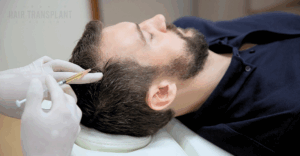Hair loss in men can be a significant concern, affecting both appearance and self-esteem. Thankfully, modern medical advancements have made hair restoration not just a possibility but a successful reality for many. Hair transplants for men have evolved, offering solutions that range from subtle enhancements to complete transformations. This guide serves as your go-to resource for understanding the intricate world of male hair restoration.
Different Types of Hair Loss in Men
Hair loss is a multifaceted issue that manifests in various forms among men, each with distinct characteristics and underlying causes. Understanding these different types of hair loss is essential for selecting the most appropriate treatment approach.
Androgenetic Alopecia (Male Pattern Baldness)
The most common type of hair loss in men is androgenetic alopecia, often referred to as male pattern baldness. This genetic condition is characterized by a progressive thinning of hair at the crown and a receding hairline, eventually leading to partial or complete baldness.
Androgenetic alopecia is influenced by hormonal factors, particularly dihydrotestosterone (DHT), which shortens the hair growth cycle and results in finer, weaker hair follicles over time.
Alopecia Areata
Alopecia areata is an autoimmune disorder that causes patchy hair loss on the scalp, face, or other parts of the body. In this condition, the immune system mistakenly attacks hair follicles, leading to sudden and unpredictable hair loss. Alopecia areata can occur at any age and may result in small, coin-sized bald patches or more extensive hair loss. While the exact cause is unknown, factors such as genetics, environmental triggers, and immune system abnormalities may contribute to its development.
Telogen Effluvium
Telogen effluvium is a temporary form of hair loss characterized by excessive shedding of hair from the scalp. This condition occurs when a significant number of hair follicles prematurely enter the telogen (resting) phase of the hair growth cycle, leading to increased hair shedding. Telogen effluvium is often triggered by factors such as physical or emotional stress, illness, hormonal changes, nutritional deficiencies, or certain medications. Unlike Androgenetic alopecia, Telogen effluvium typically resolves on its own once the underlying trigger is addressed.
Other Types of Hair Loss
In addition to these primary types, men may also experience hair loss due to various other factors, including:
Scarring Alopecia:
Also known as cicatricial alopecia, this type of hair loss results from inflammation and destruction of hair follicles, leading to permanent hair loss and scarring of the scalp.
Traction Alopecia:
Caused by repetitive pulling or tension on the hair follicles, often due to tight hairstyles or hair grooming practices.
Trichotillomania:
A psychological disorder characterized by compulsive hair pulling, resulting in noticeable hair loss and bald patches.
Medical Conditions:
Certain medical conditions such as thyroid disorders, scalp infections, or nutritional deficiencies can also contribute to hair loss in men.
Understanding the specific type of hair loss is crucial for determining the most effective treatment approach. Consultation with a healthcare professional or dermatologist can help diagnose the underlying cause of hair loss and guide individuals toward suitable treatment options tailored to their needs.
Hair Loss in Men: Why Does It Occur?
The reasons behind hair loss in men are as varied as the types themselves. Genetics play a significant role, especially in male pattern baldness. Hormonal changes, particularly in dihydrotestosterone (DHT) levels, significantly influence hair growth and loss. Lifestyle factors such as diet, stress, and smoking can also contribute to hair thinning. It’s essential to pinpoint the cause to tailor the right treatment.
Treatment Options for Hair Loss Solution
There are numerous treatment options available for male hair restoration, ranging from medications to non-surgical procedures and surgical interventions. Understanding these options can help individuals make informed decisions about addressing their hair loss concerns.
Medications
Medications are often the first line of defence against hair loss in men. Two of the most widely used medications for hair loss treatment are:
Minoxidil (Rogaine):
Minoxidil is a topical solution that is applied directly to the scalp. It works by stimulating hair follicles, prolonging the growth phase of the hair cycle, and promoting hair regrowth. Minoxidil is available over-the-counter and is suitable for treating male pattern baldness.
Finasteride (Propecia):
Finasteride is an oral medication that works by blocking the conversion of testosterone into dihydrotestosterone (DHT), a hormone that contributes to hair loss in men with androgenetic alopecia. Finasteride helps to slow down hair loss and may promote hair regrowth in some individuals. It is available by prescription and requires regular use for optimal results.
Non-Surgical Treatments
Non-surgical treatments offer alternative options for individuals seeking to address hair loss without undergoing invasive procedures. Two popular non-surgical methods include:
Low-Level Laser Therapy (LLLT) ):
LLLT involves the use of low-level laser devices or caps to stimulate hair follicles, increase blood flow to the scalp, and promote hair growth. This non-invasive treatment option is often used as a standalone therapy or in conjunction with other hair loss treatments.
Platelet Rich Plasma (PRP) Treatment):
PRP treatment involves injecting concentrated platelets derived from the patient’s blood into the scalp. These platelets contain growth factors that stimulate hair follicles, improve hair thickness, and promote hair regrowth. PRP treatment is minimally invasive and has gained popularity as a natural and effective option for hair restoration.
Surgical Interventions
For individuals seeking more permanent solutions to hair loss, surgical interventions such as hair transplantation remain the gold standard. Two common surgical procedures for hair restoration include:
Follicular Unit Transplantation (FUT):
FUT, also known as strip harvesting, involves removing a strip of scalp tissue from the donor area and dissecting it into individual follicular units for transplantation into the recipient area. This procedure leaves a linear scar at the donor site but allows for the transplantation of a large number of grafts in a single session.
Follicular Unit Excision (FUE):
FUE involves harvesting individual follicular units directly from the donor area using a specialized punch tool. The extracted grafts are then implanted into the recipient area, leaving tiny, dot-like scars that are less noticeable than those from FUT. FUE is a minimally invasive procedure that offers natural-looking results and relatively shorter recovery times compared to FUT.
Hair Transplant Cost for Men
The cost of a hair transplant can vary widely based on factors like the extent of hair loss, the type of procedure chosen, and geographical location. Typically, the price is calculated per graft, with some procedures requiring several hundred to a few thousand grafts. It’s essential to have a detailed consultation with a specialist to understand the cost implications fully.
Hair Transplant Techniques in Men
The two primary techniques in hair transplantation are Follicular Unit Transplantation (FUT) and Follicular Unit Excision (FUE). FUT, known as the strip method, involves removing a strip of scalp and dissecting it into individual grafts. FUE, often referred to as FUE extraction, on the other hand, entails the direct extraction of hair follicles from the scalp. Both methods have their advantages, and the choice largely depends on the patient’s needs and the doctor’s recommendation.
When Can You Go for a Hair Transplant?
Opting for a hair transplant is a decision that requires careful consideration. Ideal candidates are those who have stable hair loss, sufficient donor hair, and realistic expectations. It’s also crucial for potential candidates to be in good overall health. Consulting with a hair restoration expert is the best way to determine if and when a hair transplant is appropriate.
Risks and Side Effects of Hair Transplantation in Men
Like any medical procedure, hair transplants come with potential risks and side effects. These can include infection, scarring, unnatural-looking hair growth, and, in some cases, a condition known as shock loss, where hair falls out from the treated area. Choosing a qualified and experienced surgeon is vital to minimize these risks.
Conclusion
Hair loss can be a difficult challenge for men, but hair transplants and restoration offer a glimmer of hope. With the help of skilled practitioners and advanced techniques, men can regain a natural-looking, fuller head of hair and feel more confident.
While the process requires patience, investment, and a comprehensive understanding of the procedure, the transformative results often outweigh the challenges encountered along the way.
With the right approach and dedication to the journey, men can emerge from the experience with a newfound sense of confidence and pride in their appearance.





